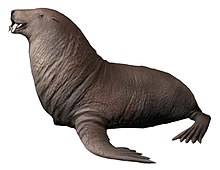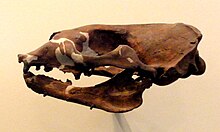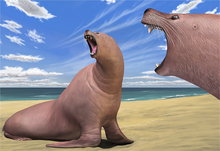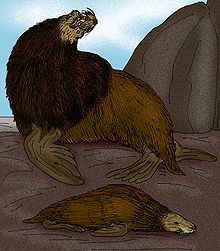
Pinnipeds are marine mammals that evolved from arctoid carnivorans that includes seals, eared seals, and walruses. There are 34 recent species of pinnipeds[1] and 102 species of fossil pinnipeds and their stem-relatives (Pinnipedimorpha), collectively referred to as pinnipedimorphs.[2] Scientists still debate on which lineage of arctoid carnviroans are the closest relatives to the pinnipedimorphs, being either more closely related to bears or to musteloids.[3][4][5][6][7] Two stem-pinniped families found outside of Pinnipedimorpha, Amphicynodontidae and Semantoridae, were in the past considered to be subfamilies of Ursidae and Mustelidae respectively.[8] In comparison to the two other major groups of marine or sea mammals, cetaceans and sirenians, pinnipeds are a relatively younger group having appeared about 24 to 38 million years ago and are still able to return on land to breed.
The list of fossil taxa is based on mostly the historiographical data from Valenzuela-Toro and Pyenson (2019).[2] The two stem-pinniped arctoid families Amphicynodontidae and Semantoridae are included here as well, although neither family are members of Pinnipedimorpha.[9] The list does not include the recently extinct Caribbean monk seal (Neomonachus tropicalis) and the Japanese sea lion (Zalophus japonicus), as they became extinct within the last two centuries.











